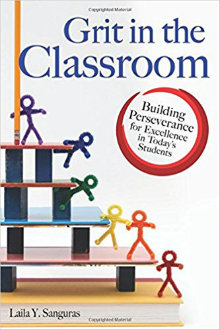A Guide to Creating a Gritty School Culture
Grit in the Classroom: Building Perseverance for Excellence in Today’s Students
By Laila Y. Sanguras
(Prufrock Press, 2017 – Learn more)
 Reviewed by Linda Bollendorf
Reviewed by Linda Bollendorf
“Grit is not the solution to the issues you may be experiencing in the classroom; it is one way to conceive of the effort and skill needed to achieve at high levels. Understanding grit provides the context we need to understand why both rigor and passion are so important to include in our curriculum” (p. 141).
 In recent years, the concepts of grit and mindset have permeated education. Teachers and administrators have re-examined their thinking about how students think and learn, and how educators can bring out the best in students. Laila Sanguras’s research-based writing and experience-laden thoughts extend this conversation to how schools can foster the development of grit in all students, no matter the ability.
In recent years, the concepts of grit and mindset have permeated education. Teachers and administrators have re-examined their thinking about how students think and learn, and how educators can bring out the best in students. Laila Sanguras’s research-based writing and experience-laden thoughts extend this conversation to how schools can foster the development of grit in all students, no matter the ability.
Adding grit to the classroom mix
The gist of the book is twofold: the three components of grit—passion, perseverance, and commitment—and how they are not only interrelated but also how each stands alone as an entity needing cultivation; and how as teachers we can better understand the nature of grit and think about how to build a culture of grit in our schools.
The author touches on a variety of concepts: mindset, perseverance, talent development, interest cultivation, goal orientation, feedback, motivation, authentic assessment, gifted learners, parenting, school culture, and school leadership, to name a few.
Grit in the Classroom offers the following chapters:
- Anatomy of Grit
- Measuring Grit
- What Gritty Classrooms Can Learn From Gifted Education and Talent Development
- Integrating Grit, Mindsets, and Motivation
- Cultivating Passionate Students
- Building Grit at Home
- Creating a Gritty School Culture
Grit and giftedness
I was particularly interested in chapter 3, where the author dove into grit in the world of giftedness. Her experience teaching gifted students provides an interesting lens into grit and academic talents. She includes thoughts on recognizing student ability and providing opportunities for students to develop their interests and talents, and she cites the importance of helping students understand their own interests and strengths so that they too can nurture them.
Although the author focuses much of chapter 3 on understanding grit and the gifted learner, she asserts that performing difficult work should be the norm for all students, whether they are labeled gifted or not, and that there are some “universal concepts” from the gifted world that can help us understand grit and think about how to apply it with all learners. “I’m arguing that it doesn’t matter whether you are labeled gifted or not—it’s what you do that matters” (p. 72).
A shift to passion and perseverance
The last chapter and conclusion contain a call to arms, so to speak. The author provides some guidelines or first steps that can be taken to cultivate a shift in school culture to encourage more passion and perseverance in staff and students. This section of the book is a must and should be bookmarked by all school leaders.
Throughout the book, the author’s teacher voice conveys a common sense tone sprinkled with humor and realism. She shares personal accounts and offers practical suggestions and viewpoints in a matter-of-fact, succinct, easy-to-read text. I found Grit in the Classroom enjoyable and interesting, and definitely recommend it as a worthwhile addition to other books about grit and mindset.
Linda Bollendorf is an instructional coach at Fleetwood Middle School in Fleetwood, Pennsylvania, where she previously taught 7th grade English for 20 years. She has a BS in English secondary education from Millersville University of Pennsylvania, and an MA in elementary education and a library science certification, both from Kutztown University of Pennsylvania. She lives in Fleetwood with her husband and four children.
































